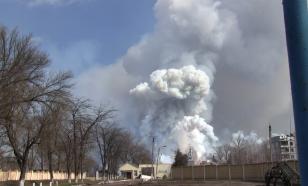Video shows no engine explosion of Spanish plane
Video taken by the Spanish airport authority AENA does not show any engine explosion while Spanair MD-82 was taking off from Madrid, Spanish media reported Friday, as investigators sought the cause of the disaster that killed 153 people.

Just 19 people survived Wednesday's takeoff crash in Madrid of the Spanair twin-engine plane bound for the Canary Islands, Spain's worst air disaster in 25 years.
Contrary to some accounts by witnesses, both the El Pais and ABC newspapers said airport security video showed no engine explosion. ABC reported that plane struggled to gain altitude, never getting higher than 50 meters (yards) before it crashed, skidded, disintegrated and burned.
Spain's civil aviation chief speculated the airplane must have suffered more than one kind of failure, because engine failure alone would not be enough to bring the plane down.
"There has been more than one breakdown," Manuel Batista, the head of Spain's Civil Aviation, was quoted as saying by El Pais. "I am not so sure that the engine failed."
Batista said modern aircraft are designed to fly on just one engine in an emergency and pilots must practice doing just this.
Investigators from the U.S. National Transportation Safety Board in the United States and Boeing - which owns airplane maker McDonnell Douglas - and engine manufacturer Pratt & Whitney have arrived in Spain to help with the probe.
The plane abandoned one takeoff attempt because of a mechanical problem with what the airline called an air intake gauge near the cockpit. But aviation experts have said this, too, was unlikely to have caused the crash.
The investigation into what brought down the plane is likely to take months, though information could come earlier from the two recovered black boxes. Spanair says one of them - the one that records technical data on the flight - is damaged.
Three of the survivors remained in critical condition Friday. One of those worst injured, a 40-year-old woman who suffered burns over 45 percent of her body, has experienced a slight improvement, the Madrid regional health department said Friday.
Five of the survivors were sitting toward the front of the plane, El Pais said.
One of them was 30-year-old Spanish telecoms engineer Rafael Vidal, who was bumped off an earlier flight because it filled up and ended up taking the doomed one. "Flying first class is what saved him," said his mother, Pilar Rodriguez, according to the daily.
Relatives of those killed in the crash kept up the heart-wrenching ordeal of identifying bodies Friday. Many bodies were burned beyond recognition and forensic teams are taking DNA samples from relatives. Around 50 sets of remains have been identified
An official funeral presided over by Madrid Archbishop Antonio Maria Rouco has been scheduled for Sept. 1, the city government said.
More stories of heroism and heartbreaking poignancy emerged.
Firefighter Francisco Martinez, part of the first teams to arrive on the fiery crash scene, told Thursday of Amalia Filloy, a mother severely injured in the crash, who insisted that rescuers pull her 11-year-old daughter Maria out first.
The woman died, along with an older daughter, but Maria survived, along with her father.
Martinez said he also rescued one of two little boys who survived the crash.
"He asked if what was happening was for real," Martinez told reporters. "He thought it was a movie, and asked where his father was and when the movie would end."
Pain and frustration started to boil over among relatives of the crash victims. Some stormed out of a tense and crowded meeting with Spanair officials Thursday night, complaining that the company was not giving out information on the cause of the crash.
"We asked questions and they did not answer," said Yurena Hernandez Marquez, a 26-year-old Spaniard. In the crash she lost two half-sisters, aged 19 and 14, whom she had just met for the first time.
Subscribe to Pravda.Ru Telegram channel, Facebook, RSS!


